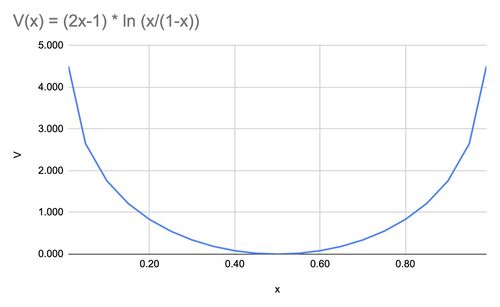Separative Work Units (SWUs)
Separative Work Units (SWUs) are the measure of work done in separating the isotopes of uranium. SWUs are not units of energy, but rather a measure of services provided by an enrichment plant. This "bizarre unit", introduced by Paul Dirac in 1941,[1] is proportional to the amount of energy or time spent, and to the total mass processed. Thus it is useful in setting the price of enrichment services.
Gaseous diffusion plants typically require 2,400 to 2,500 kW hours of electricity per SWU, while gas centrifuge plants require just 50 kWh per SWU. The average price of uranium enrichment in 2023 was $106.97 per SWU, up 6% from $101.03 in 2022.[2]
Calculation
SWUs are a function of the concentrations of the feedstock, the enriched output, and the depleted tailings.
The work necessary to separate a mass of feed of assay into a mass of product assay , and tails of mass and assay is given by the expression:[3]
where is the value function, defined as:[1]
and satisfies
The feed to product ratio is given by the expression
whereas the tails to product ratio is given by the expression
Examples
Starting with 102 kg of natural uranium (NU), it takes about 62 SWU to produce 10 kg of Low Enriched Uranium (LEU) with 235U content at 4.5%, and a tails assay of 0.3%.
A large nuclear power station with a net electrical capacity of 1300 MW requires about 25 tonnes per year of LEU with a 235U concentration of 3.75%. This quantity is produced from about 210 tonnes of NU using about 120 kSWU. An enrichment plant with a capacity of 1000 kSWU per year can enrich the uranium needed to fuel about eight large nuclear power stations.
Assuming the cost of bomb-grade highly-enriched uranium (HEU: 90% U-235) starting from natural uranium (NU: 0.7% U-235) is just the cost of enrichment ($100 per SWU) 5 kg of HEU will cost $115K. Starting from 20% U-235 the cost would be $10K.
For more examples see Uranium Enrichment / Separative Work Units These examples are relevant to the question - Will worldwide distribution of MEU (Moderately Enriched Uranium, 20% U-235, or HALEU to use official industry jargon) will this massive production and shipment of fissile material be an easy target for the Bad Guys?
Note for Wannabe Bomb Makers:
Enriching uranium is very difficult. To get above 90% (weapons grade) it takes a lot of "work" by the centrifuges. The work increases asymptotically as you approach 100% (see Figure 1). It is also difficult starting with natural uranium (0.7%). Centrifuges work best with a 50/50 mixture of isotopes. If you can steal some 20% from a nearby power plant with a "new generation" reactor, it will be a bit easier than starting with 5%, which is the best you can find in an "old generation" power plant.
Attribution
Some content on this page may previously have appeared on Wikipedia; see it's article on Separative work units for more details.
References
- ↑ 1.0 1.1 Bernstein, J. (2009). SWU for You and Me. arXiv:0906.2505
- ↑ Uranium Marketing Annual Report. US Energy Information Administration. accessed 28 July 2024.
- ↑ Fuchs, K. (1997). Selected Scientific Papers Of Sir Rudolf Peierls, With Commentary By The Author. World Scientific Publishing Company. ISBN 9789814498883.













